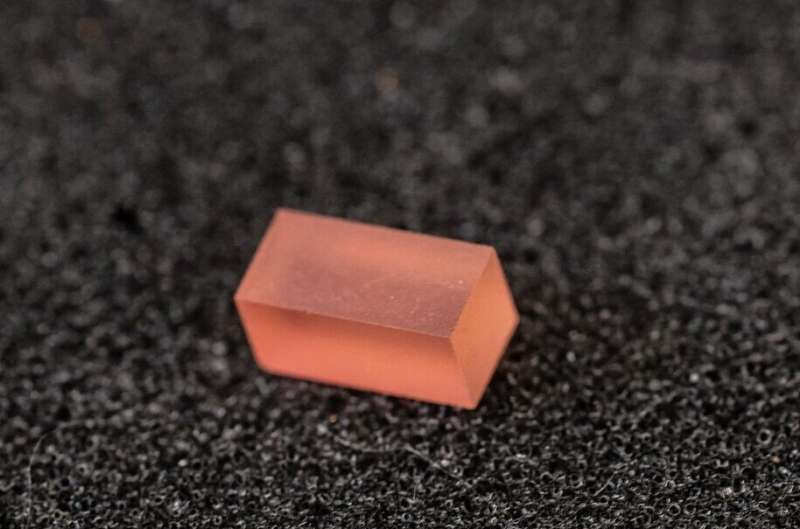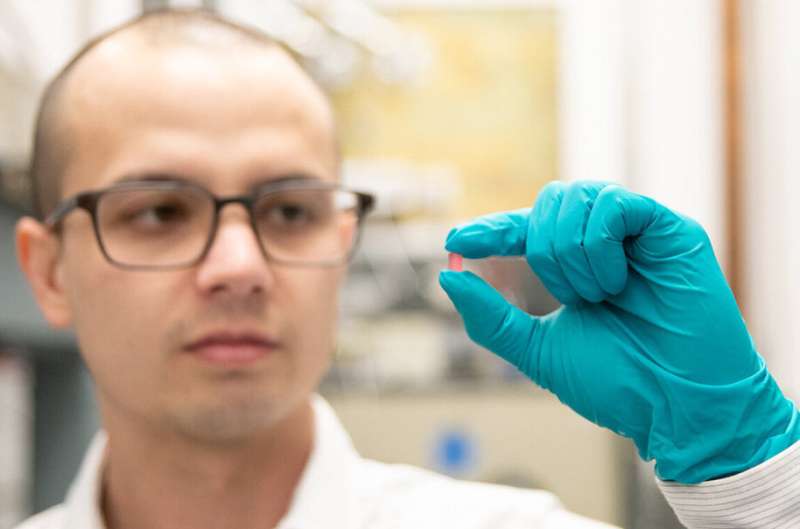This article has been reviewed according to Science X's editorial process and policies. Editors have highlighted the following attributes while ensuring the content's credibility:
fact-checked
peer-reviewed publication
trusted source
proofread
Magnetic avalanche triggered by quantum effects: 'Barkhausen noise' detected for first time

Iron screws and other so-called ferromagnetic materials are made up of atoms with electrons that act like little magnets. Normally, the orientations of the magnets are aligned within one region of the material but are not aligned from one region to the next. Think of packs of tourists in Times Square pointing to different billboards all around them. But when a magnetic field is applied, the orientations of the magnets, or spins, in the different regions line up and the material becomes fully magnetized. This would be like the packs of tourists all turning to point at the same sign.
The process of spins lining up, however, does not happen all at once. Rather, when the magnetic field is applied, different regions, or so-called domains, influence others nearby, and the changes spread across the material in a clumpy fashion. Scientists often compare this effect to an avalanche of snow, where one small lump of snow starts falling, pushing on other nearby lumps, until the entire mountainside of snow is tumbling down in the same direction.
This avalanche effect was first demonstrated in magnets by the physicist Heinrich Barkhausen in 1919. By wrapping a coil around a magnetic material and attaching it to a loudspeaker, he showed that these jumps in magnetism can be heard as a crackling sound, known today as Barkhausen noise.
Now, reporting in the journal Proceedings of the National Academy of Sciences, Caltech researchers have shown that Barkhausen noise can be produced not only through traditional, or classical means, but through quantum mechanical effects.
This is the first time quantum Barkhausen noise has been detected experimentally. The research represents an advance in fundamental physics and could one day have applications in creating quantum sensors and other electronic devices.
"Barkhausen noise is the collection of the little magnets flipping in groups," says Christopher Simon, lead author of the paper and a postdoctoral scholar in the lab of Thomas F. Rosenbaum, a professor of physics at Caltech, the president of the Institute, and the Sonja and William Davidow Presidential Chair.
"We are doing the same experiment that has been done many times, but we are doing it in a quantum material. We are seeing that the quantum effects can lead to macroscopic changes."
Usually, these magnetic flips occur classically, through thermal activation, where the particles need to temporarily gain enough energy to jump over an energy barrier. However, the new study shows that these flips can also occur quantum mechanically through a process called quantum tunneling.
In tunneling, particles can jump to the other side of an energy barrier without having to actually pass over the barrier. If one could scale up this effect to everyday objects like golf balls, it would be like the golf ball passing straight through a hill rather than having to climb up over it to get to the other side.

"In the quantum world, the ball doesn't have to go over a hill because the ball, or rather the particle, is actually a wave, and some of it is already on the other side of the hill," says Simon.
In addition to quantum tunneling, the new research shows a co-tunneling effect, in which groups of tunneling electrons are communicating with each other to drive the electron spins to flip in the same direction.
"Classically, each one of the mini avalanches, where groups of spins flip, would happen on its own," says co-author Daniel Silevitch, research professor of physics at Caltech. "But we found that through quantum tunneling, two avalanches happen in sync with each other. This is a result of two large ensembles of electrons talking to each other and, through their interactions, they make these changes. This co-tunneling effect was a surprise."
For their experiments, members of the team used a pink crystalline material called lithium holmium yttrium fluoride cooled to temperatures near absolute zero (equivalent to –273.15°C). They wrapped a coil around it, applied a magnetic field, and then measured brief jumps in voltage, not unlike what Barkhausen did in 1919 in his more simplified experiment.
The observed voltage spikes indicate when groups of electron spins flip their magnetic orientations. As the groups of spins flip, one after the other, a series of voltage spikes is observed, i.e., the Barkhausen noise.
By analyzing this noise, the researchers were able to show that a magnetic avalanche was taking place even without the presence of classical effects. Specifically, they showed that these effects were insensitive to changes in the temperature of the material. This and other analytical steps led them to conclude that quantum effects were responsible for the sweeping changes.
According to the scientists, these flipping regions can contain up to 1 million billion spins, in comparison to the entire crystal that contains approximately 1 billion trillion spins.
"We are seeing this quantum behavior in materials with up to trillions of spins. Ensembles of microscopic objects are all behaving coherently," Rosenbaum says. "This work represents the focus of our lab: to isolate quantum mechanical effects where we can quantitively understand what is going on."
Another recent PNAS paper from Rosenbaum's lab similarly looks at how tiny quantum effects can lead to larger-scale changes. In this earlier study, the researchers studied the element chromium and showed that two different types of charge modulation (involving the ions in one case and the electrons in the other) operating at different length scales can interfere quantum mechanically.
"People have studied chromium for a long time," says Rosenbaum, "but it took until now to appreciate this aspect of the quantum mechanics. It is another example of engineering simple systems to reveal quantum behavior that we can study on the macroscopic scale."
More information: C. Simon et al, Quantum Barkhausen noise induced by domain wall cotunneling, Proceedings of the National Academy of Sciences (2024). DOI: 10.1073/pnas.2315598121
Yejun Feng et al, Quantum interference in superposed lattices, Proceedings of the National Academy of Sciences (2024). DOI: 10.1073/pnas.2315787121
Journal information: Proceedings of the National Academy of Sciences
Provided by California Institute of Technology





















